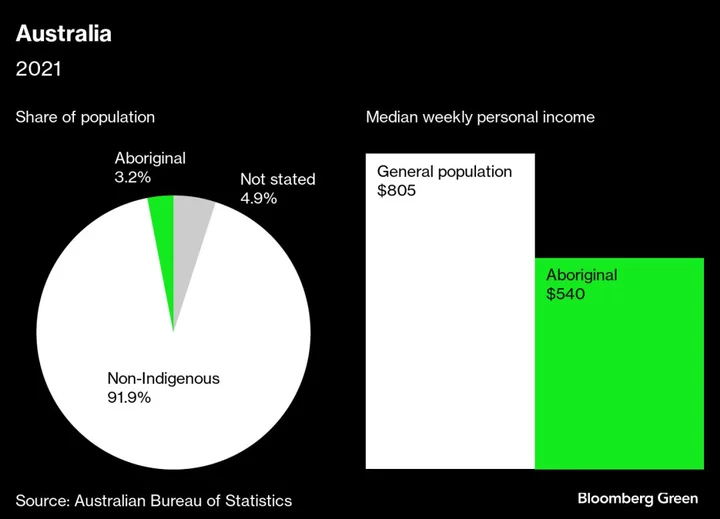One of the driest places in the world also has one of the most sophisticated water-trading markets. Australia manages to combine extreme water scarcity with billions of dollars in trading turnover.
Aboriginal people have been locked out of that lucrative market. Their water holdings have decreased 20% since 2009, according to a Bloomberg Green analysis in collaboration with researcher Lana Hartwig, leaving them with just 0.2% of the total.
The roots of the problem lie in economic and cultural disenfranchisement caused by colonization. Europeans, who arrived in Australia in the late 18th century, seized the most fertile lands and set up a new system of water rights to go with them. When the government first modernized water rights by giving away permits in the early 1900s, the landowners applied and got them. Aboriginal organizations didn’t own land and were shut out of legal ownership, so they didn’t get any water.
In the 1980s state and federal governments started giving land to Aboriginal organizations as part of restitution measures, but it was largely unsuitable for agriculture and lacked existing water rights. Around the same time, government officials started realizing that demands on the Murray-Darling Basin had started to exceed supply. Water entitlements stopped being granted freely, leaving new landowners without an easy path to permits.
“It’s heartbreaking to learn that this inequity has received so little policy attention,” says Hartwig, a research fellow at the Australian Rivers Institute at Griffith University and a researcher at Murray Lower Darling Rivers Indigenous Nations (MLDRIN).
Hartwig first calculated the water holdings of Aboriginal groups in a paper published in 2020, a painstaking analysis that involved tracking water license information. When she updated her findings for Bloomberg Green this year, she found that Aboriginal water holdings had declined even further.
Forced liquidation to pay off debts is a major reason for the trend. Even when Aboriginal people do secure water rights, they often lack the capital to harness those rights and end up selling them to pay off debts.
“People find it really difficult to make use of that, because they don’t have the cash in reserve to invest in water infrastructure,” Hartwig says. “How to get the water from the river to a crop—that costs money, it requires expertise, requires time.”
Brendan Kennedy, an Indigenous water-rights advocate who belongs to the Tati Tati tribe, believes wealthy landowners, water traders and investors have had the opportunity to build more wealth. “Every person’s right to water has been replaced with water available to a select few,” says Kennedy, who’s also deputy chair of MLDRIN. “Now if we want water, we have to find the money to buy it, and there isn’t enough water to buy.”
Because of pressure from First Nations groups, in 2018 the Australian government committed A$40 million ($25 million) to Aboriginal people to provide water for cultural and economic purposes. Five years later, activists say they’re still waiting for the money.“We recognize that First Nations peoples have waited too long,” says a spokesperson from the Department of Climate Change, Energy, the Environment and Water, a federal agency overseeing the country’s water and climate change strategy. The department said it plans to deliver funds by the end of the financial year in 2024.
Water in Australia is both an asset class and a necessity for everyday life, and Aboriginal people are often blocked from both. Some towns with Aboriginal populations lack access to clean drinking water that flows down the local river.
In the northern plains of New South Wales, large cotton growers amass water behind dams and in other infrastructure by diverting water running across the land away from natural waterways and into private reservoirs. The controversial practice, called “floodplain harvesting,” keeps water out of the rivers flowing downstream. The contrast between the haves and have-nots is apparent in Walgett, a town of 5,000 with a high concentration of Aboriginal people.
“We’re so disadvantaged that, even today, First Nations people aren’t even aware of what is really happening,” Kennedy says. “We’re locked out of all the water decisions.”
Author: Sinduja Rangarajan and Minh-Anh Nguyen

